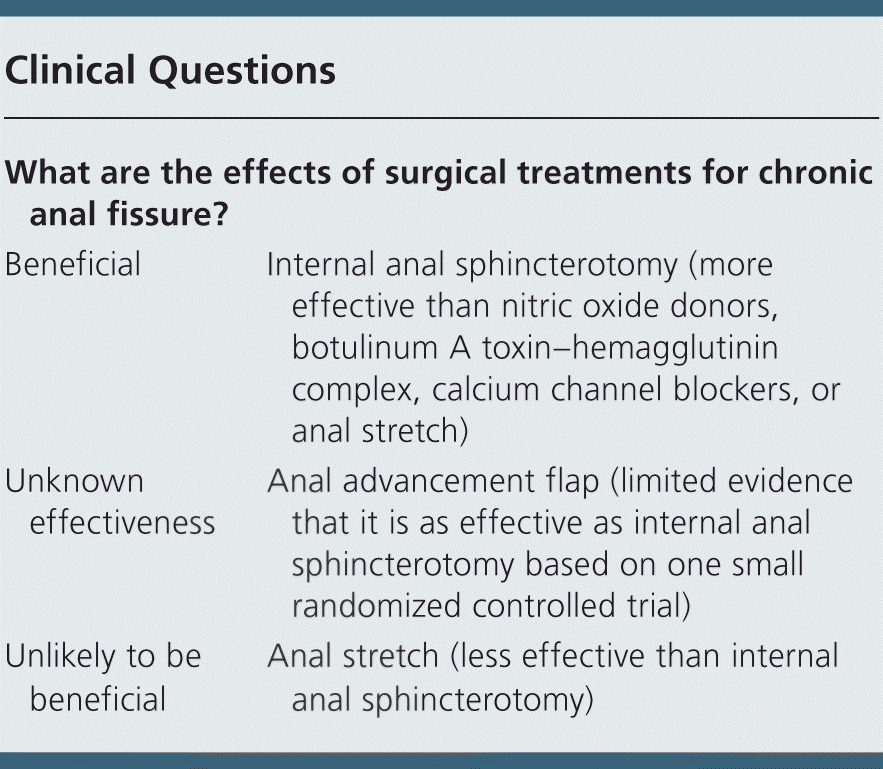
Am Fam Physician. 2016;93(6):498-499
Author disclosure: Richard L. Nelson has received fees from the American College of Physicians for web-based education modules. He is also the author of references cited in this review.
Chronic anal fissures typically occur in the midline, with visible sphincter fibers at the fissure base, anal papillae, sentinel piles, and indurated margins.
Anal fissures are a common cause of anal pain during and for one to two hours after defecation. The cause is not fully understood, but low intake of dietary fiber may be a risk factor.
Chronic fissures typically have a cyclical history of intermittent healing and recurrence, but about 35% will eventually heal, at least temporarily, without intervention.
Atypical features, such as multiple, large, or irregular fissures, or those not in the midline, may indicate underlying malignancy, sexually transmitted infections, inflammatory bowel disease, or trauma.
Internal anal sphincterotomy is more effective than medical therapy for chronic anal fissure in adults. It improves fissure healing compared with treatment with nitric oxide donors (topical nitroglycerin, topical isosorbide dinitrate), botulinum A toxin–hemagglutinin complex, and calcium channel blockers (nifedipine, diltiazem).
Internal anal sphincterotomy also increases fissure healing compared with digital anal stretch, and anal stretch is more likely to cause flatus incontinence. One small randomized controlled trial found limited evidence that controlled anal dilation may be equivalent to sphincterotomy in fissure healing, with negligible incontinence risk.
We do not know whether anal dilation is more effective than topical nitroglycerin at reducing the proportion of persons with anal fissure.
We do not know whether internal anal sphincterotomy is better or worse than anal advancement flap in improving fissure healing.
Open partial lateral internal anal sphincterotomy may be equivalent to closed partial internal anal sphincterotomy in fissure healing.
Longer internal anal sphincter division (to the dentate line, as opposed to the fissure apex only) may be more effective at reducing anal fissure.
The risk of minor flatus or fecal incontinence is greater with internal anal sphincterotomy than with botulinum toxin. Topical nitroglycerin increases the risk of headache compared with internal anal sphincterotomy.
Postsurgical fecal incontinence may be confused with postsurgical leakage (a short-term adverse effect). Confirming postsurgical leakage requires long-term follow-up (at least 12 months).

| What are the effects of surgical treatments for chronic anal fissure? | |
| Beneficial | Internal anal sphincterotomy (more effective than nitric oxide donors, botulinum A toxin–hemagglutinin complex, calcium channel blockers, or anal stretch) |
| Unknown effectiveness | Anal advancement flap (limited evidence that it is as effective as internal anal sphincterotomy based on one small randomized controlled trial) |
| Unlikely to be beneficial | Anal stretch (less effective than internal anal sphincterotomy) |
Definition
An anal fissure is an ulcer or tear in the squamous epithelium of the distal anal canal, usually in the posterior midline. Persons with an anal fissure usually experience pain during defecation and for one to two hours afterward. Multiple fissures and large, irregular, or large and irregular fissures, or fissures off the midline are considered atypical. Atypical fissures may be caused by malignancy, chemotherapy, sexually transmitted infections, inflammatory bowel disease, or other traumas. Treatments for atypical fissures are not included in this review. It is not clear what the best treatment strategy is in persons who present with a painless anal fissure and in whom an atypical etiology has been ruled out.
Acute anal fissures have sharply demarcated, fresh mucosal edges, often with granulation tissue at the base. Acute fissures are believed to often heal spontaneously. Anal fissures persisting for longer than four weeks, or recurrent fissures, are generally defined as chronic. Chronic anal fissures have distinct anatomical features, such as visible sphincter fibers at the fissure base, anal papillae, sentinel piles, and indurated margins. Most published studies only require the presence of one of these signs or symptoms to classify a fissure as chronic. This review addresses only chronic anal fissures.
Incidence and Prevalence
Anal fissures are a common cause of anal pain in all age groups, but we found no reliable evidence about precise incidence.
Etiology and Risk Factors
The cause of anal fissure is not fully understood. Low intake of dietary fiber may be a risk factor for the development of acute anal fissure. Persons with anal fissure often have raised resting anal canal pressures with anal spasm, which may give rise to ischemia.
Prognosis
Chronic anal fissure typically has a cyclical pain history, with intermittent healing and then recurrence. One systematic review found healing rates of about 35% without intervention, depending on the length of study follow-up.
search date: January 2014
Adapted with permission from Nelson RL. Anal fissure (chronic). Clin Evid Handbook.
